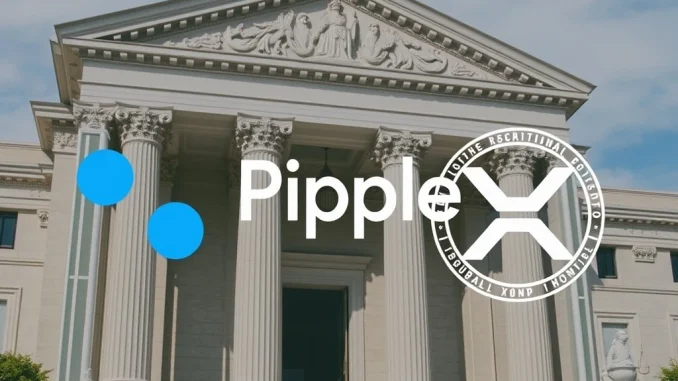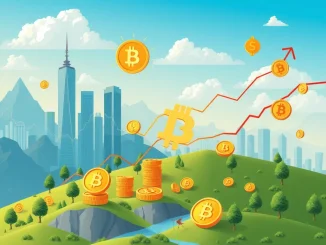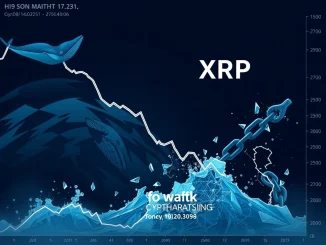
Big news from the crypto world! Ripple, the blockchain payments company behind the XRP digital asset, has taken a significant step towards deeper integration with traditional finance by applying for a U.S. national banking license. This move positions Ripple closer to the regulated financial sector, but interestingly, it hasn’t triggered a major price surge for XRP.
What is Ripple’s Banking License Application All About?
Ripple’s application was submitted to the Office of the Comptroller of the Currency (OCC). For those unfamiliar, the OCC is an independent bureau within the U.S. Department of the Treasury that charters, regulates, and supervises all national banks and federal savings associations. Obtaining a national banking charter is a major undertaking and signals Ripple’s intent to operate within the highly regulated U.S. financial system.
If approved, this license would grant Ripple the authority to engage in certain banking activities related to digital assets. Specifically, reports suggest it would allow Ripple to:
- Provide custody services for digital assets.
- Manage reserves for stablecoins, including their proposed dollar-pegged stablecoin, RLUSD.
- Potentially offer other regulated financial services involving digital currencies.
This is a strategic maneuver by Ripple the company, aiming to expand its service offerings and build trust with financial institutions by operating under federal banking oversight.
How Does the OCC Application Benefit Ripple?
While the immediate impact on XRP’s price has been minimal, the OCC application represents several potential benefits for Ripple as a business entity:
Operating as a regulated bank could significantly enhance Ripple’s credibility and legitimacy in the eyes of traditional financial institutions, which are often hesitant to engage with unregulated crypto entities. A banking license could streamline partnerships and integrations with banks and payment providers.
The ability to offer regulated custody services and manage stablecoin reserves under a national charter opens up new revenue streams and expands Ripple’s potential market reach within the U.S.
Securing a banking license would demonstrate Ripple’s commitment to compliance and regulatory adherence, a crucial factor in the often-turbulent world of cryptocurrency regulation.
Why Isn’t This Boosting XRP Price Significantly?
Despite the seemingly positive news for Ripple’s business, XRP’s price saw only a modest rise of about 3% following the announcement. Why the muted reaction? The core reason lies in the distinction between Ripple the company and XRP the digital asset, particularly in the context of U.S. regulation.
The banking license application, while significant for Ripple’s operational framework and ability to handle certain digital assets like stablecoins and potentially custody, doesn’t directly address or resolve the primary regulatory hurdle impacting XRP itself in the U.S. market.
A court ruling from 2023 determined that programmatic sales of XRP were not securities, but institutional sales were. This ruling continues to restrict Ripple’s ability to sell XRP directly to U.S. institutions on a large scale. The banking license application doesn’t change this fundamental limitation on institutional XRP adoption within the U.S. for investment purposes.
Furthermore, the banking license primarily focuses on Ripple’s activities related to custody and stablecoins, which are services provided by Ripple, not necessarily functions inherent to or solely reliant on the XRP ledger or the XRP asset itself in these specific contexts. While XRP is central to Ripple’s payment solutions (like On-Demand Liquidity), the banking license doesn’t automatically increase demand or utility for XRP in ways that would immediately drive up its price.
As BeInCrypto reported, while the move improves Ripple’s infrastructure integration potential, it doesn’t directly enhance XRP’s utility or legal status in a way that would trigger a significant short-term price increase based on this news alone.
What’s Next for Ripple and XRP?
Ripple’s pursuit of a U.S. banking license is a clear indicator of its long-term strategy to become a regulated financial technology company operating within the traditional system. This path involves navigating complex regulatory landscapes and building bridges with established finance.
For XRP holders, the immediate impact of this specific news might be limited. The asset’s price movements are influenced by a multitude of factors, including broader market trends, ongoing regulatory clarity (or lack thereof) regarding its status, adoption of Ripple’s payment solutions that *do* utilize XRP (like ODL), and overall investor sentiment.
While the banking license could indirectly benefit XRP in the long run by strengthening Ripple’s position and potentially leading to more use cases built on regulated infrastructure, it doesn’t bypass the existing regulatory constraints on institutional XRP sales in the U.S. The market’s reaction reflects this nuanced reality.
In Summary
Ripple is making a bold, strategic move by applying for a U.S. national banking license with the OCC. This aims to solidify its position within the regulated financial sector, particularly concerning digital assets like stablecoins and custody services. However, this development hasn’t translated into a significant boost for XRP’s price because the application doesn’t immediately resolve the existing U.S. regulatory limitations on institutional XRP sales stemming from past court decisions. It’s a pivotal step for Ripple’s business structure, but for XRP’s price, the market seems to be waiting for more direct catalysts related to its regulatory status or utility adoption.



